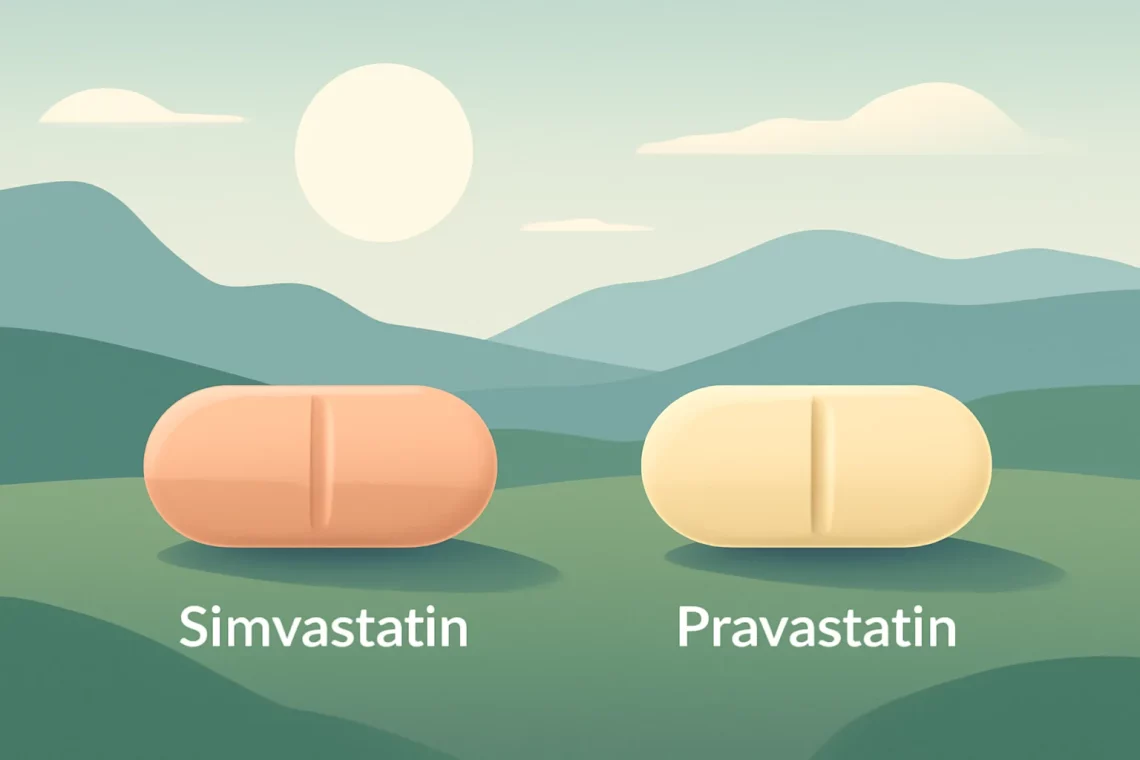
Simvastatin vs Pravastatin: Which Statin is Right for You?
Cholesterol management is a critical aspect of maintaining overall health and preventing cardiovascular diseases. With an increasing number of individuals experiencing elevated cholesterol levels, the demand for effective treatments has surged. Among the most commonly prescribed medications for lowering cholesterol are statins, which work by inhibiting cholesterol production in the liver. Simvastatin and pravastatin are two popular options in this category, each with its own unique profile of benefits and side effects. Understanding the differences between these two medications can empower patients to make informed decisions about their treatment options. This article delves into the mechanisms, benefits, and potential side effects of simvastatin and pravastatin, providing insights that are essential for anyone considering these medications.
Mechanism of Action
Both simvastatin and pravastatin belong to the statin class of drugs, which are primarily used to manage high cholesterol levels. They work by inhibiting the enzyme HMG-CoA reductase, which plays a crucial role in the body’s cholesterol synthesis process. By blocking this enzyme, statins effectively lower the production of cholesterol in the liver, leading to a decrease in the overall cholesterol levels in the bloodstream.
Simvastatin is often regarded as a more potent statin compared to pravastatin. This means that it can lower cholesterol levels more significantly in many patients. However, this potency comes with a risk of increased side effects, particularly muscle-related issues. Simvastatin is typically prescribed for individuals with significantly elevated cholesterol levels or those at a higher risk of cardiovascular events.
On the other hand, pravastatin is considered to have a milder effect on cholesterol levels. It is often recommended for patients who may be more susceptible to the side effects associated with stronger statins. Pravastatin has a unique advantage: it has a lower likelihood of interacting with other medications due to its fewer drug-drug interactions. This can be particularly beneficial for patients who are taking multiple prescriptions.
Both medications also have a positive impact on lowering LDL (low-density lipoprotein) cholesterol, often referred to as “bad” cholesterol. Additionally, they may have a modest effect on increasing HDL (high-density lipoprotein) cholesterol, known as “good” cholesterol. This dual action is crucial for cardiovascular health and can significantly reduce the risk of heart disease.
Benefits and Effectiveness
The primary benefit of both simvastatin and pravastatin is their effectiveness in lowering LDL cholesterol levels, which is a major contributor to atherosclerosis and cardiovascular diseases. Studies have shown that both medications can lead to a reduction in heart attack and stroke risk, making them valuable tools in preventive medicine.
Simvastatin is often the go-to choice for patients requiring aggressive cholesterol management. Its higher potency means that it can achieve target LDL levels more quickly and effectively in many cases. For individuals with familial hypercholesterolemia or those who have not responded adequately to lifestyle changes alone, simvastatin can be particularly effective. Moreover, simvastatin has been linked to additional benefits, such as reducing inflammation and stabilizing atherosclerotic plaques, which can further minimize cardiovascular risks.
Pravastatin, while less potent, offers its own set of advantages. Its safety profile is often viewed as more favorable, especially for older adults and those with a history of muscle problems. It is also less likely to cause liver enzyme elevations compared to simvastatin, making it a safer option for patients with underlying liver conditions.
In terms of overall effectiveness, both medications have demonstrated their capabilities in large-scale clinical trials. While simvastatin may provide more significant cholesterol reductions, pravastatin’s safety profile makes it an excellent choice for long-term management in certain populations. Ultimately, the choice between these two medications should be based on individual health profiles, cholesterol levels, and risk factors.
Side Effects and Considerations
Like any medication, both simvastatin and pravastatin come with a risk of side effects. Understanding these potential adverse effects is crucial for patients considering treatment options.
Simvastatin is associated with a higher incidence of muscle-related side effects, including myopathy and rhabdomyolysis. These conditions can lead to muscle pain, weakness, and, in severe cases, kidney damage. Patients taking simvastatin should be monitored for signs of muscle discomfort, especially during the initial phase of treatment or when the dosage is increased. Other common side effects include gastrointestinal issues, such as nausea and diarrhea, and an increased risk of liver enzyme elevation.
On the contrary, pravastatin has a more favorable side effect profile. While it, too, can cause muscle pain and liver enzyme elevation, these issues are reported less frequently compared to simvastatin. This makes pravastatin a preferred option for individuals who may be at risk for such side effects, including older adults or those with a history of muscle problems.
Another consideration is drug interactions. Simvastatin is known to interact with several other medications, including certain antibiotics and antifungal medications, which can increase the risk of muscle-related side effects. Pravastatin, on the other hand, has fewer interactions, making it a safer choice for patients on multiple medications.
Ultimately, the decision to choose between simvastatin and pravastatin should take into account not only the efficacy of the drug in lowering cholesterol but also the patient’s overall health profile, potential side effects, and any other medications they may be taking.
Conclusion
In conclusion, both simvastatin and pravastatin are effective statins that play a significant role in managing cholesterol levels and reducing cardiovascular risks. While simvastatin offers higher potency and more significant cholesterol reduction, pravastatin provides a safer alternative for those concerned about side effects. The choice between these medications should be personalized, taking into account individual health conditions, lifestyle factors, and the potential for side effects.
Patients are encouraged to engage in open discussions with their healthcare providers to determine the most suitable option based on their unique circumstances. Regular monitoring and follow-up are essential to ensure optimal treatment outcomes and to address any side effects that may arise during the course of treatment.
**Disclaimer:** This article is for informational purposes only and does not constitute medical advice. Always consult your healthcare provider for advice regarding your health and medication.




